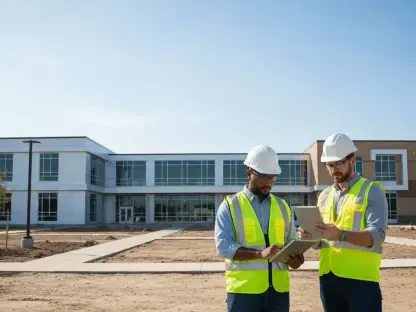In an era where urban sprawl and skyrocketing energy costs challenge the very foundation of modern infrastructure, Building Management Systems (BMS) have emerged as indispensable tools for creating smarter, more sustainable environments. These sophisticated systems integrate control over critical building functions like heating, ventilation, air conditioning (HVAC), lighting, security, and energy management, delivering not only operational efficiency but also enhanced occupant well-being. With the global BMS market valued at USD 16.97 billion in 2023 and projected to soar to USD 59.62 billion by 2032 at a compound annual growth rate (CAGR) of 14.7%, the industry is witnessing unprecedented momentum. This remarkable growth trajectory underscores a worldwide pivot toward sustainability, driven by pressing environmental concerns and rapid technological advancements. But what are the underlying forces propelling this market forward? From the urgent demand for energy conservation to the transformative power of digital innovation, the factors at play are both complex and compelling. This article delves into the key drivers shaping the BMS landscape, examining regional variations, technological trends, and the hurdles that must be navigated. As buildings evolve from mere structures into dynamic ecosystems, understanding these dynamics offers critical insights into the future of infrastructure management through the next decade.
Energy Efficiency as a Fundamental Catalyst
The push for energy efficiency stands as a cornerstone of BMS adoption across the globe. Buildings account for a substantial portion of worldwide energy consumption, often contributing to inefficiencies that inflate costs and environmental footprints. BMS solutions address this by optimizing HVAC operations, lighting schedules, and electrical usage, slashing waste and driving down expenses. This capability resonates strongly in a world increasingly focused on reducing carbon emissions. Regulatory frameworks, such as the Energy Performance of Buildings Directive (EPBD) in Europe, mandate stricter standards for building efficiency, positioning BMS as a vital tool for compliance. Beyond mere adherence to policy, the financial benefits of reduced utility bills provide a tangible incentive for property owners and managers. The alignment of economic savings with ecological responsibility creates a powerful impetus for investment, particularly in commercial and industrial sectors where energy demands are high. As sustainability becomes a non-negotiable priority, BMS is no longer an option but a strategic necessity for forward-thinking stakeholders aiming to balance profitability with planetary health.
Moreover, the global emphasis on green building certifications, like LEED in the United States, further accelerates BMS integration. These certifications often require advanced systems to monitor and manage energy performance, pushing developers to embed BMS into new constructions and retrofits alike. The ripple effect extends to tenant expectations, as businesses and residents increasingly seek spaces that reflect environmental stewardship. Governments worldwide are also stepping in with incentives and subsidies to offset initial costs, making adoption more accessible across various market segments. This convergence of policy, market demand, and financial pragmatism underscores energy efficiency as a primary engine of growth. It’s a trend that transcends borders, uniting diverse regions under a shared goal of minimizing energy waste while maximizing operational value, ensuring that BMS remains at the forefront of sustainable building practices through 2032.
Technological Advancements Redefining Building Management
Technological innovation is reshaping the BMS market at a breathtaking pace, turning traditional building operations into intelligent, data-driven ecosystems. The integration of the Internet of Things (IoT) has been a game-changer, enabling real-time monitoring and control through a network of connected sensors and devices. This connectivity allows building managers to oversee operations remotely, adjusting settings instantly to respond to occupancy patterns or environmental changes. Such flexibility not only enhances efficiency but also reduces response times for maintenance issues. IoT-enabled BMS platforms are particularly valuable in sprawling complexes or multi-site portfolios, where centralized oversight can streamline management and cut overhead costs. As digital transformation sweeps through the construction and real estate sectors, these systems are becoming the backbone of what are now termed “smart buildings,” setting a new standard for how infrastructure interacts with its users.
Artificial Intelligence (AI) adds another layer of sophistication to BMS capabilities, introducing predictive analytics and anomaly detection into the mix. By analyzing historical data, AI can forecast energy needs, optimize usage patterns, and identify potential system failures before they occur, thereby minimizing downtime and repair costs. This proactive approach contrasts sharply with reactive maintenance models of the past, offering a glimpse into a future where buildings anticipate and adapt to challenges autonomously. Cloud-based platforms further amplify this trend by providing scalability and accessibility, allowing managers to access dashboards from anywhere, anytime. The synergy of AI, IoT, and cloud technology is not just enhancing BMS functionality but also redefining competitive edges in the market. As these advancements continue to evolve, they promise to unlock even greater efficiencies, ensuring that BMS remains a critical component of modern infrastructure well into the coming decade.
Urbanization Fueling Demand in Emerging Markets
The relentless pace of urbanization, particularly in regions like Asia-Pacific, the Middle East, and Africa, is a significant driver behind the expanding BMS market. As cities swell with population growth, the strain on existing infrastructure intensifies, necessitating solutions that can manage resources effectively within confined urban spaces. BMS offers a way to optimize building performance amidst this pressure, ensuring that high-density environments remain livable and efficient. Smart city initiatives, which are gaining traction in developing economies, often place BMS at the core of their planning, integrating these systems into everything from residential towers to transportation hubs. This trend is especially pronounced in countries like India and China, where massive infrastructure projects are underway to accommodate burgeoning urban populations. The sheer scale of these developments highlights the critical role BMS plays in supporting sustainable growth.
Beyond smart cities, the boom in commercial real estate and industrial facilities further amplifies demand. New office complexes, shopping malls, and manufacturing plants require advanced systems to manage energy, security, and operational needs efficiently. In many emerging markets, governments are investing heavily in such projects as part of broader economic development strategies, creating a fertile ground for BMS vendors. The focus isn’t just on new builds; retrofitting older structures with modern systems is also gaining momentum as urban centers seek to modernize without starting from scratch. This dual approach of new construction and upgrades ensures a steady stream of opportunities for market players. As urbanization continues to reshape global landscapes, the reliance on BMS to balance growth with sustainability will only deepen, positioning it as a linchpin of future-ready cities through 2032.
Enhancing Occupant Well-Being and Safety
Modern buildings are increasingly viewed as environments that must nurture the health and comfort of their occupants, a shift that has propelled BMS into a pivotal role. These systems meticulously regulate indoor conditions such as air quality, temperature, and lighting, creating spaces that support well-being. In commercial settings, this translates into tangible benefits like improved employee productivity and satisfaction, as a comfortable workspace fosters focus and morale. Property owners recognize this correlation, investing in BMS to attract and retain tenants, whether in office buildings or residential complexes. The emphasis on occupant experience is reshaping how buildings are designed and operated, with BMS providing the tools to tailor environments to specific needs, from adjusting lighting for circadian rhythms to ensuring optimal ventilation for health.
Safety, too, is a paramount concern driving BMS adoption, especially in the wake of global health challenges. Features like touchless access controls and advanced air quality monitoring have surged in importance, addressing concerns about hygiene and disease prevention in shared spaces. Additionally, BMS integrates security protocols such as surveillance and emergency response systems, ensuring rapid action during crises. This dual focus on comfort and protection is particularly critical in high-traffic areas like hospitals, airports, and educational institutions, where occupant safety can’t be compromised. As societal expectations evolve, building managers are compelled to prioritize these aspects, embedding BMS as a non-negotiable element of infrastructure. This trend reflects a broader recognition that buildings are more than physical structures—they’re ecosystems where technology must safeguard and enhance human life.
Navigating Barriers to Widespread Adoption
Despite the clear benefits and growing demand, the BMS market grapples with substantial challenges that could temper its expansion. High upfront costs remain a significant obstacle, particularly for small and medium-sized enterprises with limited budgets. Installing a comprehensive BMS often involves not just the system itself but also extensive integration work, training, and sometimes structural modifications. These expenses can deter adoption, especially in cost-sensitive markets or among property owners managing older buildings with tighter financial constraints. While long-term savings on energy and maintenance often justify the investment, the initial financial barrier can delay decisions, slowing market penetration in certain segments. Addressing this issue requires innovative pricing models or government support to make BMS more accessible across diverse economic landscapes.
Cybersecurity risks present another formidable challenge as BMS becomes increasingly reliant on IoT and cloud-based platforms. The connectivity that makes these systems so powerful also exposes them to potential cyberattacks, which could disrupt operations or compromise sensitive data like building access codes or occupant information. This vulnerability is a growing concern as buildings become more digitized, prompting calls for robust security protocols and encryption standards within BMS design. Additionally, integrating modern systems with legacy infrastructure poses technical difficulties, often requiring costly customization and risking operational downtime. These hurdles highlight the need for industry collaboration to develop solutions that balance innovation with security and compatibility. Overcoming these barriers will be crucial to sustaining the market’s growth trajectory toward 2032.
Regional Variations and Growth Opportunities
The BMS market exhibits distinct regional dynamics, with North America currently holding a dominant position due to its early embrace of smart building technologies and significant infrastructure investments. The United States leads with initiatives like green building incentives and widespread adoption of certifications that prioritize energy efficiency, while Canada shows steady growth in sectors such as healthcare and education. Strong regulatory support and a mature vendor ecosystem further solidify the region’s leadership, making it a hub for innovation and deployment. This established foundation allows North American markets to focus on refining BMS capabilities, integrating cutting-edge technologies to maintain a competitive edge. However, sustaining this dominance will depend on addressing emerging challenges like cybersecurity and cost barriers that could impact broader adoption.
In contrast, Asia-Pacific emerges as the region with the most explosive growth potential, driven by rapid urbanization and large-scale infrastructure projects. Countries like China, India, and Japan are at the forefront, fueled by smart city programs and population-driven demand for efficient buildings. The scale of development in this region—from towering commercial hubs to expansive residential complexes—creates a massive market for BMS solutions. Europe, meanwhile, is propelled by stringent environmental regulations, with policies like the EPBD pushing for energy-efficient infrastructure. Nations such as Germany and France are integrating BMS into broader sustainability and modernization efforts, ensuring steady demand. These regional variations highlight diverse drivers, from policy in Europe to scale in Asia-Pacific, shaping a multifaceted global market with unique opportunities and challenges through the forecast period.
Competitive Forces and Industry Innovation
The BMS market is a dynamic arena where established corporations and nimble startups vie for dominance through innovation and strategic positioning. Giants like Honeywell, Siemens, and Schneider Electric leverage their extensive portfolios and global reach to cater to a wide array of building needs, from commercial skyscrapers to industrial facilities. Their ability to offer comprehensive solutions, backed by decades of expertise, gives them a formidable presence, often setting industry benchmarks. These players are not resting on their laurels; they continuously invest in research to integrate the latest technologies, ensuring their offerings remain relevant in an increasingly digital landscape. Their influence shapes market expectations, pushing for higher standards in efficiency and functionality that benefit end-users across sectors.
Startups, however, are injecting fresh energy into the market, challenging incumbents with cutting-edge approaches. Companies like Infogrid and Facilio are carving out niches by focusing on AI-driven platforms and autonomous control systems, emphasizing energy optimization and user-centric design. Their agility allows them to adapt quickly to emerging trends, such as health-focused building features or cloud scalability, often outpacing larger competitors in specific areas. Recent launches, like Honeywell’s AI-powered Connected Solutions, underscore the industry’s shift toward intelligent, data-centric systems, a direction echoed by smaller innovators. This competitive tension fosters a cycle of advancement, where established and emerging players alike drive the market forward. As this rivalry intensifies, it ensures that BMS solutions evolve to meet future demands, keeping the industry vibrant and responsive through 2032.
Future Pathways and Strategic Considerations
Looking back, the journey of the Building Management Systems market reflects a powerful convergence of necessity and innovation, as stakeholders tackle the dual challenges of sustainability and urbanization. The market’s climb from a valuation of USD 16.97 billion in 2023 toward a projected USD 59.62 billion by 2032 bears witness to the transformative impact of energy efficiency mandates and technological breakthroughs. While North America leads with early adoption, Asia-Pacific’s rapid ascent signals a shift in global focus, driven by infrastructure demands. Challenges like high costs and cybersecurity risks test the industry’s resilience, yet advancements in AI and IoT consistently offer pathways to overcome them.
Moving forward, the focus must shift to actionable strategies that ensure sustained growth. Industry players should prioritize developing cost-effective solutions, perhaps through modular systems or financing options, to democratize access across market segments. Strengthening cybersecurity frameworks will be paramount as connectivity deepens, requiring collaboration between vendors, policymakers, and building owners to establish robust standards. Additionally, fostering partnerships to address legacy integration issues can unlock potential in older building stocks, a largely untapped area. Governments can play a pivotal role by expanding incentives and regulatory support, particularly in emerging markets where adoption lags. By aligning innovation with accessibility, the BMS market can solidify its role as a cornerstone of sustainable, intelligent infrastructure, paving the way for a future where buildings not only function efficiently but also enhance human and environmental well-being.









